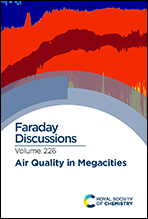Using a coupled LES aerosol–radiation model to investigate the importance of aerosol–boundary layer feedback in a Beijing haze episode
Abstract
Haze episodes, characterised by extremely high aerosol concentrations and a reduction in visibility to less than 10 km, are a frequent occurrence in wintertime Beijing, despite policy interventions leading to an overall improvement in average annual air quality. The main drivers in the onset of haze episodes in wintertime Beijing are changing synoptic conditions, however, aerosol–radiation interactions and their feedback on boundary layer meteorology are thought to play an essential role in the intensity and longevity of haze episodes. In this study we use a coupled LES aerosol–radiation model (UCLALES-SALSA), which we have recently configured for the urban environment of Beijing. The model’s high resolution and control over meteorological and aerosol conditions as well as atmospheric processes means we can directly elucidate and quantify the importance of specific aspects of the aerosol–radiation–meteorology feedback in the cumulative stage of Beijing haze. The main results presented here show (a) synoptic scale meteorology has a larger impact on boundary layer suppression than high aerosol concentrations and (b) unlike previous results obtained using regional models or observationally driven analyses, there is no threshold value at which the aerosol–radiation–meteorology feedback has a significant effect on PBL height. Rather, our work shows that for the aerosol composition in this case study, the role of the feedback effect in reducing PBL height increases under shallow boundary layer conditions and with increasing pollution loading in an almost linear fashion. This lack of a threshold found for our case study has important policy implications since interventions based on such a value will not result in large reductions associated with turning off the feedback process. Furthermore, this work directly shows that although the right synoptic changes are a prerequisite for pollution episodes in Beijing, local and regional emissions drive increases in aerosol load that are sufficient to initiate the aerosol feedback loop. This further drives suppression of the boundary layer top and promotes stagnation of air and increased stability, which can be self-sustaining. This results in higher surface aerosol concentrations for extended periods of time, with severe consequences for human health [Lv et al., Atmos. Environ., 2016, 124, 98–108; Wang et al., Atmos. Chem. Phys., 2019, 19(10), 6949–6967].

- This article is part of the themed collection: Air quality in megacities


 Please wait while we load your content...
Please wait while we load your content...